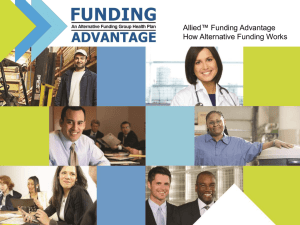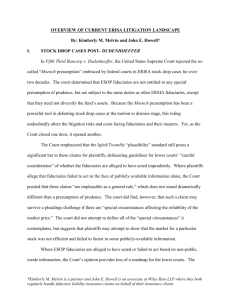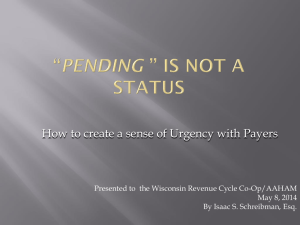What Are “Plan Assets”? - United Benefit Advisors
advertisement
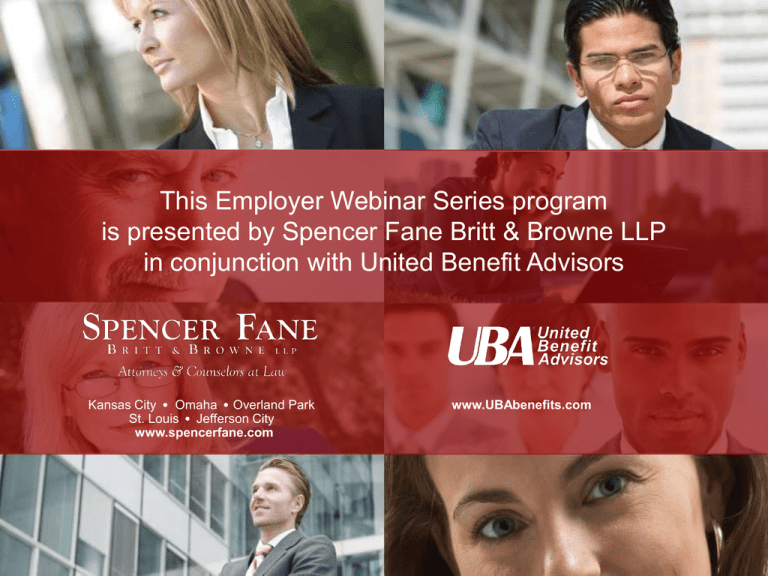
This Employer Webinar Series program is presented by Spencer Fane Britt & Browne LLP in conjunction with United Benefit Advisors This Employer Webinar Series program is presented by Spencer Fane Britt & Browne LLP in conjunction with United Benefit Advisors Kansas City = Omaha = Overland Park St. Louis = Jefferson City www.spencerfane.com www.UBAbenefits.com Compliance 201 for Plan Administrators Gregory L. Ash Julia M. Vander Weele June 15, 2010 Copyright 2009 2 Presenters Gregory L. Ash, JD Partner gash@spencerfane.com 913-327-5115 Julia Vander Weele, JD Partner jvanderweele@spencerfane.com 816-292-8182 Copyright 2009 3 Agenda Copyright 2009 Understanding When Welfare “Plan Assets” Must be Held in Trust ERISA Preemption Claims and Appeal Procedures and Judicial Review of Denied Claims Cafeteria Plan Compliance Issues Fiduciary Duties Plan Discrimination Issues After Health Care Reform 4 Key ERISA Requirements Copyright 2009 Plan document – See “Compliance 101” SPD, SMM – See “Compliance 101” Participant disclosures – See “Compliance 101” Form 5500 and SAR – See “Compliance 101” Plan assets held in trust Fidelity bond Reasonable claim/appeal procedures Fiduciary standards 5 Funding of Welfare Plans Copyright 2009 No ERISA funding standards for welfare plans Four primary funding methods: General assets of employer Insurance Separate funds set aside for plan purposes Contributions from participants 6 Why Does Funding Matter? Copyright 2009 ERISA’s trust requirement applies only to “funded” plans (those with “plan assets”) ERISA’s exclusive benefit and fiduciary requirements apply to arrangements with “plan assets” Bonding requirement applies when there are “plan assets” Funding method dictates extent of state regulation 7 What Are “Plan Assets”? Copyright 2009 ERISA does not define “plan assets” Generally, two categories of “plan assets”: Participant/beneficiary contributions are always plan assets Use of separate funds to pay benefits may create plan assets (e.g., trust, separate account in plan’s name) 8 ERISA’s Trust Requirement Copyright 2009 General Rule: Section 403(a) of ERISA requires plan assets to be held in trust Trust options: VEBA Taxable trust 9 Exceptions to Trust Requirement Exemption for assets held by insurance company DOL nonenforcement policy (Technical Release 9201) for participant contributions Under cafeteria plan, if such contributions are sole source of plan assets and contributions held as general corporate assets Under insured plan accepting participant contributions, if: Copyright 2009 Benefits paid exclusively through insurance policies Premiums paid directly by employer from general assets Participant contributions forwarded within 3 months Certain insurance refunds returned to participants Also applies to after-tax and COBRA contributions 10 Examples of Nonenforcement Policy Copyright 2009 Insured Plan – Employer Contributions Only No employee contributions; no cafeteria plan Employer sends premiums directly to insurer from corporate checking account No plan assets; no trust required 11 Examples of Nonenforcement Policy Copyright 2009 Insured Plan – Employer Contributions Only COBRA contributions paid to employer, who pays all premiums to insurer out of corporate checking account COBRA premiums are plan assets; trust requirement subject to nonenforcement policy 12 Examples of Nonenforcement Policy Copyright 2009 Insured Plan – Employee Contributions Through Payroll Deduction or 125 Plan After-tax or pre-tax employee contributions Employer sends one check for employee and employer contributions to insurer Employee contributions are plan assets; trust requirement subject to nonenforcement policy 13 Examples of Nonenforcement Policy Copyright 2009 Insured Plan – TPA Collects and Forwards Employee Contributions Employees pay premiums through payroll deduction, collected by employer, who forwards to TPA in single corporate check TPA forwards premiums to insurer Employee contributions are plan assets; trust may be required 14 Examples of Nonenforcement Policy Copyright 2009 Insured Plan – Premium Payments from VEBA Employee and employer contributions made to VEBA Premium payments to insurer made by VEBA Employee contributions and VEBA assets are “plan assets”; trust present 15 Examples of Nonenforcement Policy Copyright 2009 Self-Insured Plan – Benefits Paid from Checking Account in Plan’s Name Employer contributions only; no employee contributions Employer pays benefits from checking account in plan’s name Plan assets due to employer’s transfer to checking account in plan’s name; trust required 16 Caveats to Nonenforcement Policy Exclusive benefit rule still applies Fiduciary duties still apply Participants and beneficiaries may still sue to enforce Copyright 2009 17 ERISA Preemption Copyright 2009 Primary purpose of ERISA is uniform, national system of enforcement ERISA contains a broad “preemption” clause, superseding application of most state laws State laws (statutes or common law) that “relate to” ERISA plans are preempted (i.e., do not apply) 18 The “Savings Clause” Copyright 2009 Many state insurance laws are “saved” from preemption State insurance laws governing insurance policies (e.g., to require mandated benefits) still apply Fully-insured plans therefore remain subject to indirect state regulation 19 ERISA Preemption – So What? Copyright 2009 Preemption protects employers and fiduciaries Self-insured plans not subject to mandated benefits State causes of action for benefits are preempted Bad-faith refusal to pay Claims for punitive and compensatory damages Generally no jury trials 20 Claims and Appeals Copyright 2009 ERISA requires “reasonable” procedures Rules/time frames differ by benefit Group health Disability Other (severance, life, AD&D, etc.) Formal claim/appeal procedures must appear in SPD (or be furnished in separate document with SPD) 21 Who is Responsible? Copyright 2009 Insured Plans – Insurer typically decides all claims and appeals Employer may retain responsibility for distributing claims and appeals procedures with SPD Make sure policy and certificate accurately reflect who decides claims and appeals Self-Insured Plans – Plan fiduciaries decide claims and appeals 22 Compliance Affords Protection Compliance with reasonable procedures affords protection to plan sponsors Copyright 2009 Claimants must “exhaust” administrative procedures before suing Unreasonable procedures, or failure to follow them, allows immediate resort to courts Courts defer to decisions made under such procedures unless arbitrary and capricious 1989 Supreme Court decision in Firestone Tire & Rubber v. Bruch But plan (and SPD) must afford plan administrator or fiduciary the discretionary authority to interpret plan 23 Judicial Deference Copyright 2009 Even conflicted decision makers entitled to deference Metropolitan Life v. Glenn (S. Ct. 2008) – when “dual role” administrators both fund plan and decide claims, conflict of interest is just one factor courts must weigh Conkright v. Frommert (S. Ct. 2010) – if administrator’s first decision is rejected by court, administrator still entitled to deference on second review 24 Steps to Preserve Deferential Review Copyright 2009 Wall off claims from financial departments Avoid placing CFO on claims committee Have two committees; one to hear claims, and one to review plan finances Document and follow procedures for claim/appeal processing 25 Steps to Preserve Deferential Review Copyright 2009 Produce thorough, carefully reasoned claim decisions Denial letters should articulate all grounds on which claim is being rejected Include citations to applicable plan provisions Describe appeal process (for claim denials) or right to bring suit (for appeal denials) 26 Steps to Preserve Deferential Review Do not weigh economic consequences of claim decisions Minimize incentives for claim denials Copyright 2009 Don’t ask about extent of benefits that may be paid Ensure that claims examiners aren’t paid more for denying claims Make sure the party to whom the plan gives discretionary authority is the party deciding claims/appeals 27 What is a Cafeteria Plan? Copyright 2009 Choice between taxable benefits (e.g., cash) and non-taxable benefits (e.g., health care coverage) Section 125 is the exclusive means by which employer can offer a choice without the choice itself resulting in taxable income to the employee (under “constructive receipt” doctrine) A plan offering a choice between only taxable benefits (cash or paid time off), or only nontaxable benefits (e.g., a “flex plan”) is not a cafeteria plan 28 Qualified Benefits Copyright 2009 Employer-provided health coverage Health flexible spending account (“FSA”) Dependent care FSA Group-term life insurance AD&D insurance STD and LTD insurance Adoption assistance HSA contributions 401(k) contributions 29 Impermissible (But Tax-Favored) Benefits Copyright 2009 Scholarships Educational assistance benefits Dependent life insurance Long-term care insurance Fringe benefits 403(b) deferrals 30 Eligibility Copyright 2009 Current employees Former employees (so long as plan is not maintained predominantly for them) But not self-employed individuals, sole proprietors, partners, directors, or 2% shareholders of Scorporations 31 Written Plan Document Copyright 2009 Must have a written plan document Program must be operated in accordance with plan’s terms Plan must be adopted and effective on or before first day of plan year Any amendments must be made through formal written instrument 32 Value to Employees Advantages for employees: Disadvantages for employees: Copyright 2009 No income tax No FICA or Medicare tax Generally, no state or city tax Allows choice among benefits (or cash) Irrevocable elections “Use-it-or-lose-it” rule Possibly lower Social Security benefits 33 Value to Employers Copyright 2009 Advantages for employers: No FICA or Medicare tax Cushion blow of premium increases Non-comparable employer HSA contributions Disadvantages for employers: Set-up and administration costs “Uniform coverage” rule (under health FSAs) 34 Election Rules Copyright 2009 General Rule: Elections must be made – and irrevocable – before beginning of coverage period (generally, 12 months) Several exceptions specified in IRS regulations Exceptions apply only if also set forth in plan document 35 Cafeteria Plans and Health Care Reform Copyright 2009 OTC medicines (other than insulin) may not be reimbursed from FSA, HRA, HSA, or Archer MSA – unless prescribed by a physician (effective in 2011) Excise tax on non-medical distributions from HSA increased from 10% to 20% (effective in 2011) Health FSA contributions capped at $2,500 (effective in 2013) 36 Fiduciary Basics Copyright 2009 Who Are Fiduciaries? Discretionary authority or control concerning management or administration of plan Any authority or control over management or disposition of plan assets Renders investment advice for a fee “Named” fiduciary 37 Fiduciary Duties Copyright 2009 Exclusive Benefit Rule… fiduciaries must discharge their duties solely in the interests of participants and beneficiaries, and for the exclusive purpose of: providing benefits, or defraying reasonable expenses of plan administration 38 Fiduciary Duties Prudent Expert Rule . . . fiduciaries must discharge their duties: Copyright 2009 With the care, skill, prudence, and diligence under the circumstances then prevailing that a prudent person acting in a like capacity and familiar with such matters would use in the conduct of an enterprise of a like character and with like aims 39 Fiduciary Duties Comply with Plan Documents . . . fiduciaries must discharge their duties: Copyright 2009 In accordance with the documents and instruments governing the plan 40 Fiduciary Duties Duty to Monitor . . . “At reasonable intervals the performance of … other fiduciaries should be reviewed by the appointing fiduciary in such manner as may be reasonably expected to ensure that their performance has been in compliance with the terms of the plan and statutory standards, and satisfies the needs of the plan.” Copyright 2009 41 Minimizing Fiduciary Risk Carefully Review Plan Documents Watch What You Say to Plan Participants Identify and Educate Fiduciaries Document Plan Governance Structure Hold Regular Meetings Choose Service Providers Carefully Review Fiduciary Liability Insurance Copyright 2009 42 Discrimination Issues Copyright 2009 As part of health care reform, fully insured plans must comply with nondiscrimination requirements of Code Section 105(h) These are the same rules to which self-funded plans are already subject 43 Discrimination Issues Copyright 2009 Plans may not discriminate in favor of “highly compensated individuals” in terms of eligibility to participate or benefits HCI = five highest paid officers, any 10% or more owners, and the highest paid 25% of all employees 44 Discrimination Issues Effective for plan year beginning on or after September 23, 2010 (January 1, 2011 for a calendar-year plan) Grandfathered plans exempt Copyright 2009 Unclear whether renewal or change in carriers will destroy grandfathered status 45 Discrimination Issues Copyright 2009 Consequences of noncompliance fall on the plan (in the form of a $100 daily penalty) In contrast to self-funded plans, where consequences of noncompliance fall on the highly compensated individuals (in the form of taxable benefits) 46 Contact Information Gregory L. Ash, JD Partner gash@spencerfane.com 913-327-5115 Julia Vander Weele, JD Partner jvanderweele@spencerfane.com 816-292-8182 www.benefitsinbrief.com Copyright 2009 47 This webinar has been submitted to HRCI for 1.5 hours of recertification credit toward PHR, SPHR and GPHR designation through the HR Certification Institute. At this time, UBA has not received notification of approval from HRCI. Once received, UBA will send an email to each attendee notifying them of the event number. As always, certificates will not be sent for this event. Thank You For Your Participation Kansas City = Omaha = Overland Park St. Louis = Jefferson City www.spencerfane.com www.UBAbenefits.com
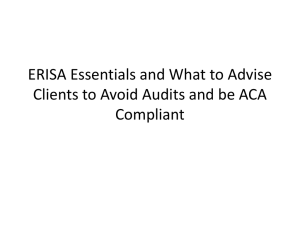
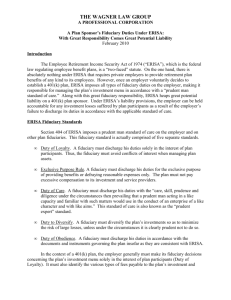
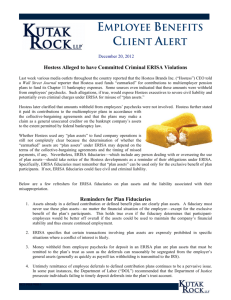
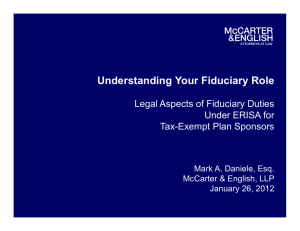
![Mark Whitenack Digital Assets PowerPoint Presentation []](http://s2.studylib.net/store/data/005383425_1-9cf830a5f2e9fc777daa963eb9460c8e-300x300.png)


